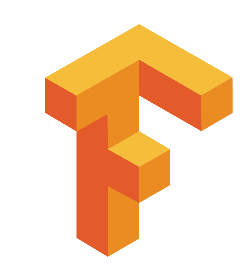TensorFlow

Figure: TensorFlow
Tensorflow is a machine learning framework which helps both beginners and experts in the field to design and deploy their machine learning applications. The framework provides a common basis through many pre-built functions, ready to use instantly, saving developers a lot of time by not having to implement everything from scratch. TensorFlow is a flexible library designed to work on any platform, even mobile devices.
TensorFlow was originally developed by the Google Brain team for internal google use. The first open-source version was released in 2015, a powerful machine learning library with support for several languages. Features that have been added since the first release include machine learning in JavaScript, deployment on Kubernetes, and deep learning in computer graphics. Tensorflow itself is written in Python, C++ and CUDA.
Some noteable companies that make use of Tensorflow include Coca-Cola, Intel and Twitter. More information can be found at https://www.tensorflow.org/.
The Team

Figure: team
Contributions
TensorFlow: making machine learning manageable
Over the last decade, machine learning has become an increasingly popular solution to solve complex modern-day challenges. Its applications include a diverse range of topics such as image recognition, diagnosing medical conditions or fraud detection. As more distinct fields and industries gain interest in incorporating machine learning techniques into their products, the need for a comprehensive and adaptable machine learning platform arises. This is where TensorFlow comes in, an end-to-end open-source platform for machine learning to easily build and train models, supported by a large ecosystem of tools, libraries and community resources. TensorFlow enables researchers to experiment and push the boundaries of this AI technique while developers can easily build and deploy their machine learning powered applications. With its many options for development and deployment reflected by the number of supported programming languages and hardware platforms, TensorFlow is a very versatile solution applicable to various different domains.
Embedding Vision into Architecture
During the previous chapter we discussed what TensorFlow aims to achieve as a product both in its present and future context. As we have seen, this ambitious project tries to suit different use cases with a high degree of flexibility and efficiency making for a not so trivial objective. To realize such a vision, TensorFlow just like any other major project requires a solid foundation supporting all of the smaller building blocks. In this chapter we will focus on how these goals are made possible through means of proper architectural components and the interconnections between them. First, let’s see what kind of different perspectives there are on architecture and how they relate to TensorFlow.
Combining quality and collaboration in TensorFlow
As we have seen earlier, TensorFlow is a project of substantial size both in terms of codebase as well as the community surrounding it. With so many people working on such a large application it becomes very hard for anyone to carry a complete view of the entire system in their mind. Developers working on certain semi-isolated parts of the software might introduce modifications that unknowingly impact functionalities elsewhere in the system leading to bugs or even failures. Maintaining a high level of quality becomes an undeniable challenge itself, especially for an open-source project involving countless different contributors. This article will provide you with some insight as to which maintenance methods and tools are being employed by the TensorFlow team to keep their project healthy.